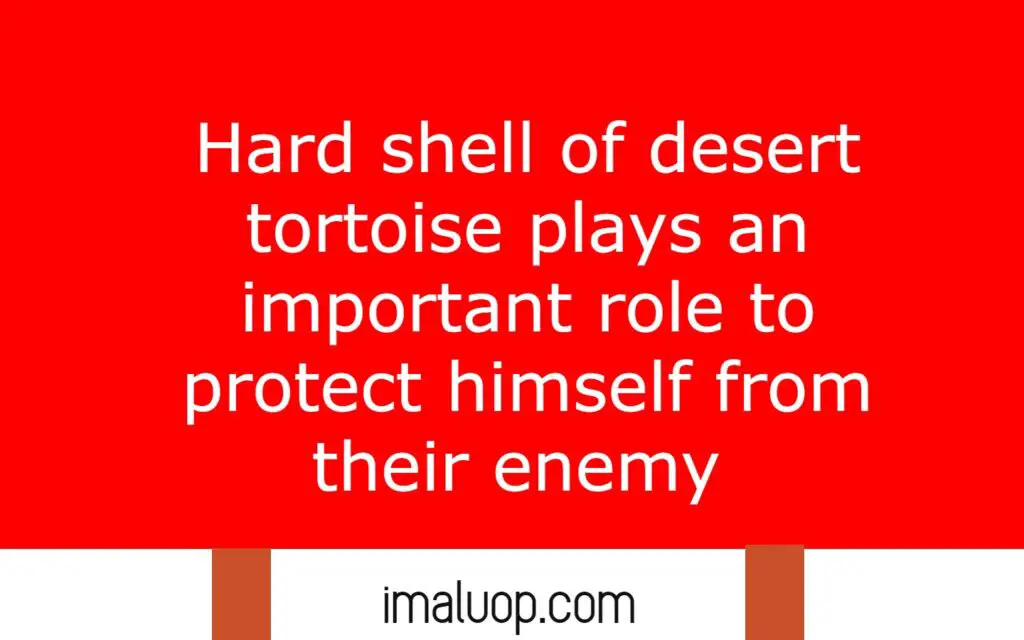Hi, we have discussed adaptation in different organisms in different environments now we will discuss all major adaptations in desert tortoise. When most of the organisms feel difficulty then desert tortoise can easily live in desert conditions. Special physical structure and behaviour make the desert tortoise able to live in such extreme conditions.
Now we will learn how desert tortoises remain active in desert conditions below.
Table of Contents
Hard Shell:
Hard shell of desert tortoise plays an important role to protect himself from their enemy and environmental extremities. Different predators like fox, snakes, eagles, bobcat when try to hunt the desert tortoise, they draw their head and limbs into the shell and get rid from the predator’s animals.

They get some extra coverage against sunlight by using their shells in hot daytime. But there are also some disadvantages of that shell because when they get upside down due to any reason it becomes very difficult to land on ground which sometimes lead to death as a result of suffocation or long time exposure.
Efficient Waste Management:
Desert tortoises have a special large sized bladder which can store large amounts of nitrogenous waste materials. They can absorb extra water from the nitrogenous waste materials which saves them from extra water loss.
They excrete dry semi-solid waste materials which helps them to keep more water in their body. When water availability is much better they drink excess water which they store in their large bladder. And when water availability becomes poor desert tortoise can utilise the water stored in the bladder.
Specialised Limbs:
Desert tortoises have special legs which help them to walk efficiently in sand and dig burrows in sands. Their front legs are flattened, hind legs are stumpy and thick which have sharp claws.
Flattened and stumpy legs are very helpful to walk in hot sand because flat legs can spread the body weight equally. Desert tortoises dig burrows in sand with the help of front legs to protect themselves against very high temperature and predators animals.

When female desert tortoises lay eggs, use their hind legs to dig egg nests in sand.
Behavioural Adaptation:
Some special behaviour makes them alive in extreme desert conditions. They can dig burrows in sand which is very deep sometimes it may be upto 35 feet long. They can use these burrows when the temperature is very high and it is impossible for them to live on the surface of the desert.
When the temperature is very low in freeze cold they can utilise the burrows they dug. And this deep burrow is safe for them because most of the enemy animals are unable to enter their burrows.
When these extreme conditions come in front of them they dig, enter into their burrows and remain in an inactive stage until conditions become tolerable for them. During these inactive states they remain alive without taking any food or water for a long time.
Sometimes they can live upto a year without drinking water because they can utilise the water content present in their food.
Rain Water Storage:
In water shortage conditions we often think about rain water harvesting. Do you know that the desert tortoise can also think of rainwater like we think about it. I know it would be strange to you but it is true the desert tortoise can harvest rainwater.

They reach the place in the desert where rain can arrive and dig the sand to create depression in the ground to store the rainwater. Now think how it is possible for them to forecast about the rain they can sense the possibilities of rain in an area.
When rain occurs water store in the depression they made in the sand and utilise it like a brilliant human being.
Resource: Adaptation in Desert Tortoise
Read More: Adaptation in Camel Adaptation for Desert
Hi Everyone!!! Welcome to Imaluop. Imaluop always try to learn some new and he want to share to other people. Here we will try to learn various topics on Science, specially on Biological Sciences.
